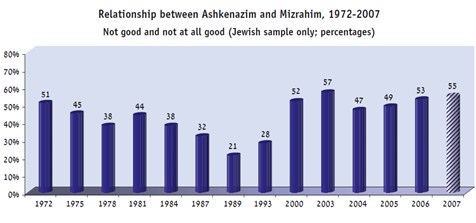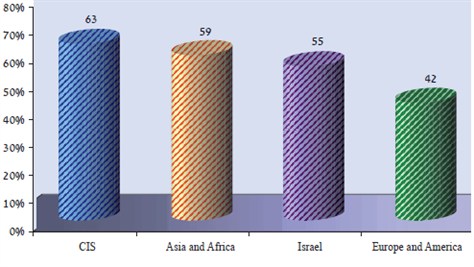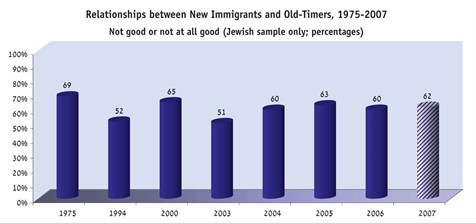Israel: A Society of Immigrants
Since its establishment in 1948, Israel's demographics have shifted greatly due to large immigrant waves (aliyot). This article, originally written in Hebrew for the Israel Democracy Institute's online journal Parliament, examines several models of cultural absorption, analyzes the success of Israeli absorption efforts in the past, and proposes possible improvements for the future.
Models of Immigrant Absorption
Introduction
Since the founding of the state, profound demographic changes have taken place in Israeli society as a result of successive waves of immigration (aliyot). Each immigrant group, with its own unique characteristics, has had to contend with the difficulties of integrating into an emerging society in a constant state of flux. Over the years, Israel's social-cultural-political discourse has changed: Gradually, the "melting pot" policy that sought to establish a uniform and unified Israeli collective faded, and a more pluralistic approach evolved, one that stresses individualization and particularism and accepts the existence of a multicultural identity. Consequently, each of the major aliyot was received in a different way, with the manner of its acceptance affecting its assimilation into Israeli society.
Models of Immigrant Absorption
There are several models of cultural absorption, each yielding a different outcome:
- In the assimilation model, immigrants adopt the values of the dominant culture, whether voluntarily or in response to the demands of the new society, with the goal of fashioning themselves after members of the host society.
- In the integration model, immigrants adopt some of the new cultural patterns of the receiving society while retaining certain patterns of their old culture, due to a desire to preserve their former identity, if only in part, and the need for a sense of continuity, belonging, and self-esteem.
- In the segregation model, immigrants retain their former patterns of behavior and do not adopt the new patterns of the receiving society. As a rule, this type of model comes to the fore when the majority group in the host society refuses to accept the newcomers, or when the latter are opposed to the culture of the new society.
- In the marginalization model, the cultural shock experienced by new immigrants leads to feelings of loss, estrangement, lack of belonging, and alienation. As a result, they are unable to form a connection with the dominant majority and are shunted to the margins of society.
In addition to these models, the unique characteristics of the particular migrant group and the economic, political, and cultural changes in the receiving society must be taken into account. These factors, taken in combination, have a decisive effect not only on the absorption process but on the society as a whole.
1950s: The Asian and North African Aliyah
Following the mass immigrations of the late 1940s and early 1950s, Jews of Asian and North African origin (henceforth Mizrahim) made up 40% of Israel's Jewish population. But the demographic shift in Israeli society was not reflected in the balance of power, and the ruling elite remained largely Ashkenazi.
Since the aliyah of the 1950s, the Mizrahim had been discriminated against politically, as demonstrated by their lack of representation in the corridors of power. Likewise, they were ranked in the lower echelons in terms of income level, standard of living, and occupation. Their feelings of injustice and discrimination came to a head in the Wadi Salib riots of 1959, which began with a chance confrontation between the police and a resident of Haifa's Wadi Salib neighborhood and quickly escalated into a series of violent demonstrations throughout the city. While this was a one-time, localized event, it had ramifications for Israeli society as a whole: first, the riots led to a rise in electoral support for the Herut movement among Jewish immigrants from North Africa; and second, the conflagration marked the beginning of the emergence of class consciousness among Mizrahi Jews.
In the early 1970s, the confluence of ethnic and social-economic rifts found potent expression in the founding of the Israeli Black Panther movement, led by second-generation North African immigrants and residents of Jerusalem's Musrara neighborhood who were protesting what they saw as the Establishment's disregard of social problems. To achieve their central goal of narrowing the social-economic gap, the group used violent tactics, including furious demonstrations and confrontations with police. Not only did they object to the conditions granted them by the state compared with those of the Ashkenazi Jews who had arrived together with them in the early years of the state, but they sought the same treatment as the Russian immigrants of the early '70s; toward this end, they demanded government assistance to improve the living conditions of second-generation North African immigrants, who were still languishing in poverty. This situation led to bitter tensions between new immigrants (from the 1970s) and earlier arrivals (from the 1950s), as illustrated in figure 3 (below) from the 2007 Israel Democracy Index: In 1975, a record 69% of the population characterized relations between new and longstanding immigrant populations as "not good" or "not at all good."
While the Black Panthers did not achieve major successes on the political front, the '70s and early '80s were marked by fierce tensions between Ashkenazim and Mizrahim as a result of the publicity garnered by the movement and the social-cultural awareness that it generated. As shown in figure 1, in 1971 (one year after the movement's founding), one-half of the population (51%) characterized relations between Ashkenazim and Mizrahim as either "not good" or "not at all good." While this figure dropped somewhat by 1975 (to 45%), it was still high.
Figure 1

In 1977, the social protest of the Mizrahim spread to the political arena, sweeping the Likud party to power in the Ninth Knesset. First- and second-generation immigrants, believing that the Likud under Menachem Begin would faithfully represent their interests and reduce the social-economic gap, gave the party their vote. Perhaps it was their sense of victory that created an atmosphere of reconciliation: in 1978, one year after the so-called "political upheaval," only 38% of Israelis described relations between Ashkenazim and Mizrahim as "not good" or "not at all good."
Following this brief respite, however, the worsening economic crisis of the early 1980s saw a widening of the social-economic divide, adding to the friction between Ashkenazim and Mizrahim. In 1981, 44% of the public characterized relations between the two groups as "not good" or "not at all good."
During the 1980s and 1990s, a change took place in the social-political sphere with the founding of such religious- and ethnic-oriented parties as TAMI (Movement for Jewish Tradition) in 1981; and SHAS (World Union of Sephardi Torah Guardians) in 1984, dedicated to "restoring the crown [of Sephardi Torah observance and ethnic pride] to its former glory." With its stated goal of rectifying the economic and social discrimination inflicted, in its view, on generations of Mizrahim in Israel, Shas also drew a connection between Israel's ethnic and social-economic divides. The party's strength grew during the 1990s amid the worsening of tensions in these areas; in the elections to the 15th Knesset in 1999, Shas won 17 seats, a fact that amply demonstrated the centrality of ethnic friction in the social-political discourse. In fact, whereas in 1989 only 21% of Israeli respondents felt that relations between Ashkenazim and Mizrahim were "not good" or "not at all good" (with 28% responding similarly in 1993), by 2000 the situation had deteriorated to the point where 52% held that the ethnic divide was still present and that relations between the groups were not good.
Since 2000, public opinion concerning relations between Ashkenazim and Mizrahim has stabilized somewhat, although the figures themselves are not encouraging: 2003 saw a record 57% who characterized relations between the groups as "not good." While there was a slight decline in 2004 in the proportion of respondents selecting "not good" (47%), the percentage has been rising steadily since then (to 55% in 2007).
An analysis of relations between Ashkenazim and Mizrahim in 2007, broken down by country of origin of the respondents, paints a similar picture: As shown in figure 2, 59% of Israelis of Asian and North African origin describe relations between Ashkenazim and Mizrahim as "not good" or "not at all good," as opposed to 42% of respondents of European or American origin who hold this view—a gap of 17%. Interestingly enough, Israelis hailing from the CIS further underscore the problematic relationship between Ashkenazim and Mizrahim, with 63% labeling it "not good" (this may be due to the differential treatment given to immigrants from the CIS, causing them to stress the differences between the two groups; see below for further discussion of this disparity).
Figure 2:
Relations between Ashkenazim and Mizrahim by Country of Origin "Not good" and "Not at all good" (Jewish sample only; percentages)

Thus, while the North African immigrants of the 1950s have integrated into Israeli society, the ethnic divide still plays a key role in the prevailing political discourse in Israel, and still affects—and is affected by—the country's social-economic situation.
1980s and 1990s: The Ethiopian Aliyah
Ethiopian Jews immigrated to Israel in two principal waves:
- Of the 17,000 who moved to Israel during the 1980s, 6,700 came as part of Operation Moses (November 1984–January 1985).
- Another 45,000 immigrants came to Israel in the 1990s, 14,000 of them in Operation Solomon (May 1991).
Like the newcomers of the 1950s, Ethiopian immigrants also faced numerous problems since the community's social and economic characteristics hampered its integration:
- Human capital: A large percentage of Ethiopian immigrants were uneducated. Many were farmers, and had limited familiarity with the educational frameworks and workplaces of a modern society. These factors, together with their difficulty learning Hebrew, held back their integration into the workplace, with the result that the percentage of jobless and unemployed among Ethiopian immigrants is very large relative to these rates among the general population.
- Family structure: The family structure of Jews of Ethiopian origin differs from that of longtime Israeli families: the number of children is very large, and there are many single-parent families. Two additional traits are virtually exclusive to families of Ethiopian origin: single-parent families with three or more children, and a high incidence of fathers ages over 65 with children under age 18.
- Jewish affiliation: The Jewishness of the Ethiopian immigrants (or "Beta Israel") has been disputed by rabbis and halakhic decisors due to their unique patterns of religious behavior. In order to apply Israel's Law of Return to Ethiopian Jews, Rabbi Ovadiah Yosef issued a religious ruling that they can be recognized as Jews following a renewal of their brit milah (a limited circumcision ceremony of sorts). This formality was tremendously upsetting to most of the immigrants, and the refusal to recognize their Jewishness deepened their sense of alienation from Israeli society.
The arrival of Ethiopian immigrants took place at a time when Israeli society was facing substantial social, economic, and political challenges: the wave of aliyah from the CIS, high unemployment levels, a widening social gap, and increased poverty. These trends affected the situation of the Ethiopian immigrants and the conditions confronting them in their absorption process.
Their sense of alienation and isolation, coupled with the geographic remoteness of their new communities from the center of the country, may have been responsible for the fact that their arrival did not lead to a worsening of relations between new immigrants and "old-timers." As shown in the Democracy Index, in 1994, 52% of respondents categorized the relationship as "not good," a relatively small percentage (see figure 3, below). But over time, feelings of discrimination began to intensify among Ethiopian immigrants, as reflected in the blood donation incident of early 1996 when it was revealed that virtually every unit of blood donated by Ethiopian immigrants was destroyed without their knowledge for fear that the donors carried infectious diseases. The affair triggered an unexpectedly stormy public protest, unexpected primarily because this community is generally known for its moderation. It is too early to determine what will become of this community and whether it will integrate successfully, for even today—twenty years after their aliyah—the bulk of Jews of Ethiopian origin have yet to find their place in Israeli society.
1990s: Aliyah from the CIS
Between 1990 and 2005, 1,100,000 newcomers immigrated to Israel, 860,000 of them from the CIS, raising the country's population by 35%. In addition to its scope, this wave of immigration is distinguished by its social-cultural features:
- Motivations for immigrating: Immigration from the CIS was not necessarily motivated by Zionism but by fear of antisemitism and, primarily, by the changes that took place in the states of the former Soviet Union (FSU) following the collapse of Communism—changes that led to political, economic, and social crises, and sparked concerns of further deterioration in these areas. As a result, those who left the CIS for Israel in the 1990s did not deny their social-cultural background; on the contrary, they continued to see it as a dominant aspect of their identity and self-definition, even if they were forced by circumstances to emigrate.
- Human capital: In contrast to other aliyot, the 1990s immigration was noteworthy for its high levels of human capital: 55% of CIS immigrants had at least 13 years of education; some 41% of the 1989–1990 arrivals engaged in academic professions in their country of origin; and 34% were technicians or members of other free professions. In 2000, the percentages of academics and members of free professions among CIS immigrants dropped to 27% and 30%, respectively.
In the first decade of their aliyah, however, these immigrants did not integrate into the Israeli labor market in a manner commensurate with their professional skills; they remained at a low socioeconomic level, thereby reinforcing their sense of alienation and their inability and lack of desire to assimilate into Israeli society.
- Jewish identity: As a result of pressures by the Soviet government, and the isolation of Soviet Jews from other Jewish centers, many of them were unfamiliar with the Jewish religion. The immigrants from the FSU are secular in outlook—in their self-definition and lifestyle as well as their positions on questions of religion and state. In addition, they include individuals who are not considered Jewish according to halakhic definitions, a fact that not infrequently leads to clashes with Israel's religious and ultra-Orthodox populations.
The scope of the Soviet aliyah, the immigrants' ties to their homeland, and their concentration in specific residential areas, together with their sense of estrangement, led to a tendency toward social-cultural segregation. Some studies that examined the Israeli population's attitude toward new immigrants focused on such questions as: Do longtime residents feel that aliyah is vital to the state? Are they willing to make personal sacrifices for the sake of integrating new immigrants? Where do the new immigrants rank in the national set of priorities? According to research conducted by Elazar Leshem, in 1986 82% of the public held that aliyah is vital, while in 1992 only 71% felt this way.
Figure 3

Various groups within Israel's longstanding population have also developed differential attitudes toward the new immigrants. The sectors found to be most hostile toward immigrants from the CIS are people under the age of 30, native-born Israelis of Mizrahi origin, individuals who did not complete high school, and low-income earners. For example (as indicated in the Democracy Index), from the start of the wave of aliyah from the FSU, significant differences were found in the willingness of members of various ethnic groups to make personal sacrifices for the sake of aliyah: 47% of Jews of Asian or African origin were opposed to such concessions, compared with 29% of Jews of European or American origin. It is, therefore, not surprising that, with the widening of the social-economic divide in Israel, there was a worsening of relations between old-timers and new immigrants; in 2000, 65% of Israeli society categorized the relationship as "not good" or "not at all good."
Conclusion: Where to Next?
How well has Israeli society succeeded in absorbing the various waves of immigration? As stated, each of the aliyot experienced a different reception: The assimilation model was popular in the early years of the state, whereas the immigrants from the CIS aimed for integration into Israeli society combined with segregation, both by choice and by circumstance. It should be noted that, of all the models cited above, the most conspicuous is marginalization, which aptly describes the present status of Jews of Ethiopian origin.
The immigration difficulties encountered by newcomers still exist, and leave their mark on Israeli society every day, at a variety of levels. Even now, the public takes a dim view of relations between new immigrants and old-timers—still a major divisive factor in Israeli society. In 2007, over one-half of respondents (62%) characterized the relationship between the two groups as "not good."
There is no question that Israeli society is facing a significant challenge whose ramifications are enormous. Only time will tell if it is able to meet that challenge, to mend the rifts within, explore the social tensions, learn to know and accept "the other," and bolster the country's fragile social fabric.
Karin Tamar Schafferman a research assistant for the Israel Democracy Institute's website.
